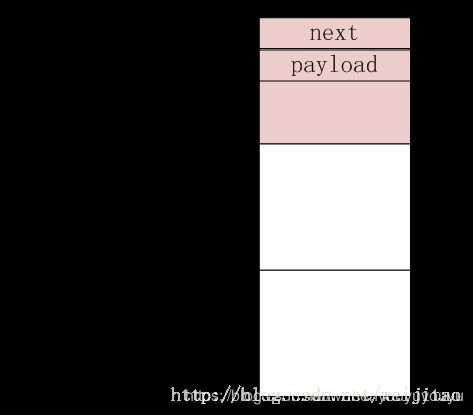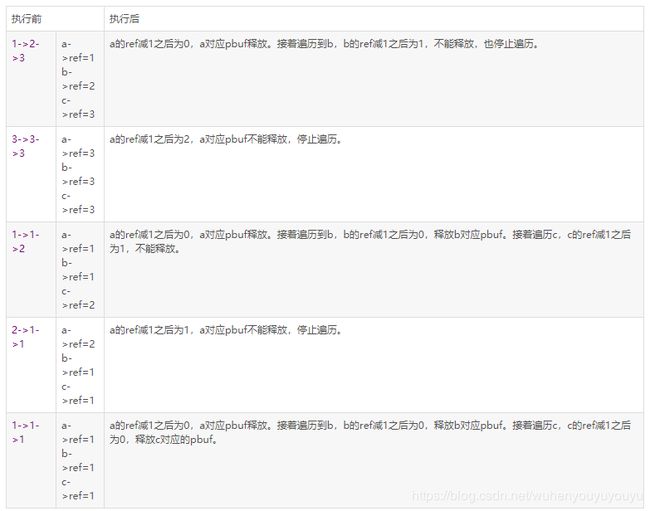Lwip pbuf分析
在BSD中用mbuf结构体来管理网络上来的各种数据包,同样lwip中也有一个类似的结构体pbuf用来管理数据包。Pbuf结构体定义如下:
struct pbuf {
struct pbuf *next;
void *payload;
u16_t tot_len;
u16_t len;
u8_t /*pbuf_type*/ type;
u8_t flags;
u16_t ref;
} ;
next: 指向下一个pbuf,在数据很大时,需要多个pbuf结构体管理,这里就是通过next指针将这些next链接起来。
payload:指向实际载荷数据的起始地址。
tot_len: 是当前pbuf数据加上next之后所有pbuf数据之和。Pbuf链表的第一个pbuf的tot_len就是所有pbuf数据的长度,最后一个pbuf的tot_len等于len。
len: 是当前pbuf的数据长度。
type: 此字段表示pbuf的类型,有四种类型:PBUF_RAM、PBUF_ROM、PBUF_REF和PBUF_POOL。
ref:此字段初始化为1,当其他pbuf->next指向自己时ref加1,在释放的时候,ref大于1的不能删除。
(我感觉红色字体是有问题的,pbuf申请时候不就是一个链式结构么,next->next...难道第一个是1,后面的
就是2,3,4等等累加?当然不是了,如果这样的话,你想想怎么去free,所以一次申请的一个pbuf链,里面
的ref字段当然都是1了。当我们想把两个pbuf拼接的时候,看你想怎么操作,可以直接拼接,也可以先用
pbuf_ref把后面的ref+1,然后再拼接,但是释放的时候,就要释放两次)
pbuf类型
PBUF_RAM
此种类型的pbuf的分配代码片段如下:
case PBUF_RAM:
p = (struct pbuf*)mem_malloc(LWIP_MEM_ALIGN_SIZE(SIZEOF_STRUCT_PBUF + offset) + LWIP_MEM_ALIGN_SIZE(length));
/* Set up internal structure of the pbuf. */
p->payload = LWIP_MEM_ALIGN((void *)((u8_t *)p + SIZEOF_STRUCT_PBUF + offset));
p->len = p->tot_len = length;
p->next = NULL;
p->type = type;
break;
PBUF_RAM类型的pbuf是调用mem_malloc函数从内存堆分配得到的,分配的大小由三部分组成:数据存储空间length、pbuf管理结构体空间SIZEOF_STRUCT_PBUF和存储协议栈头的offset。
分配内存成功之后,就是对pbuf管理结构体的初始化。Pbuf管理结构体位于分配的堆内存的开始,接着的存储协议头的offset空间,最后才是存储数据的空间。
此种类型的pbuf内存布局如下:
PBUF_ROM
PBUF_REF
上述两种类型的pbuf相似,在pbuf_alloc函数中申请内存时共用代码:
/* pbuf references existing (non-volatile static constant) ROM payload? */
case PBUF_ROM:
/* pbuf references existing (externally allocated) RAM payload? */
case PBUF_REF:
/* only allocate memory for the pbuf structure */
p = (struct pbuf *)memp_malloc(MEMP_PBUF);
/* caller must set this field properly, afterwards */
p->payload = NULL;
p->len = p->tot_len = length;
p->next = NULL;
p->type = type;
break;
代码调用memp_malloc从内存池分配MEMP_PBUF类型的内存池,仅仅分配pbuf结构体大内存,指向存储数据空间的payload指针置位NULL,此值由调用者设置为另外的一片内存空间。
PBUF_POOL
PBUF_POOL类型的pbuf是调用memp_malloc函数从内存池中分配内存的。
case PBUF_POOL:
p = (struct pbuf *)memp_malloc(MEMP_PBUF_POOL);
p->type = type;
p->next = NULL;
p->payload = LWIP_MEM_ALIGN((void *)((u8_t *)p + (SIZEOF_STRUCT_PBUF + offset)));
p->tot_len = length;
p->len=LWIP_MIN(length,PBUF_POOL_BUFSIZE_ALIGNED-LWIP_MEM_ALIGN_SIZE(offset));
从上面代码片段可以看出PBUF_POOL类型的pbuf和PBUF_RAM类型布局相似,但有一点不同的是:PBUF_POOL类型pbuf是从MEMP_PBUF_POOL内存的内存池中分配内存的,每种类型的内存池大小时固定的,如果存储数据和协议头所需要的空间大于此种类型内存池大小,则需要分配多个此种类型的内存池,并将这些内存池通过pbuf->next指针连接起来。而PBUF_RAM类型的pbuf是从内存堆中分配内存,之用申请的内存空间有剩余的连续空闲空间满足要求,则一次分配成功。
r = p;
rem_len = length - p->len ;
while (rem_len > 0) {
q = (struct pbuf *)memp_malloc(MEMP_PBUF_POOL);
q->type = type;
q->flags = 0;
q->next = NULL;
r->next = q;
q->tot_len = (u16_t)rem_len;
q->len = LWIP_MIN((u16_t)rem_len, PBUF_POOL_BUFSIZE_ALIGNED);
q->payload = (void *)((u8_t *)q + SIZEOF_STRUCT_PBUF);
q->ref = 1;
rem_len -= q->len ;
r = q;
}
上面代码首先计算需要的内存空间length和第一个pbuf指针p指向的可以空间len之差rem_len。如果rem_len大于0,说明还需要分配此种类型的内存池,于是进入while循环之中。在while循环中会分配更多的PBUF_POOL类型的pbuf直到能够存储下length大小的数据,并将这些pbuf连接起来。
需要注意的一点是除了第一个pbuf在pbuf后面需要留offset大小空间存储协议头之外,其它的pbuf中是不需要的。
PBUF_POOL类型的内存池MEMP_PBUF_POOL定义如下:
LWIP_PBUF_MEMPOOL(PBUF_POOL, PBUF_POOL_SIZE,
PBUF_POOL_BUFSIZE, "PBUF_POOL")
其大小为PBUF_POOL_BUFSIZE宏:
LWIP_MEM_ALIGN_SIZE(TCP_MSS+40+PBUF_LINK_HLEN)
包括TCP报文段最大长度MSS,40字节的tcp+IP头长度和链接层长度PBUF_LINK_HLEN
最终的PBUF_POOL类型的pbuf内存布局如下:

Pbuf释放
前面分析pbuf类型的时候讲了分配内存函数pbuf_alloc对于四种类型的pbuf各自的代码,对于PBUF_RAM类型的pbuf是从调用mem_malloc内存堆中内存,其它三种是调用函数memp_malloc从内存池中分配内存。相对应的,PBUF_RAM类型pbuf的释放就需要调用mem_free函数将内存释放回内存堆,其它三种就是memp_free函数将内存释放回相应类型的内存池了。
下面分析pbuf_free函数代码片段:
while (p != NULL) {
ref = --(p->ref );
if (ref == 0) {
q = p->next ;
type = p->type ;
if (type == PBUF_POOL) {
memp_free(MEMP_PBUF_POOL, p);
} else if (type == PBUF_ROM || type == PBUF_REF) {
memp_free(MEMP_PBUF, p);
} else {
mem_free(p);
}
p = q;
} else {
p = NULL;
}
}
pbuf的ref成员初始化时设置为1,每当有其它pbuf的next指针指向自己时ref值加1。只有当ref值为1时,表示没有其它pbuf指向自己时,才可以释放此pbuf。这里首先将pbuf的ref值减1,并赋值给变量ref。如果ref值为0说明此pbuf没有被其它的pbuf引用,这也是此pbuf能够释放的前提。如果ref值不为0,说明此pbuf不能释放,设置p为NULL,则直接退出此while循环。
对于ref等于0的情况,首先获取p->next指向的pbuf并赋值给指针q,然后根据此pbuf的type分别调用不同的释放函数。
◆PBUF_POOL类型
调用memp_free函数将p的内存空间返回给MEMP_PBUF_POOL类型的内存池。
◆PBUF_ROM和PBUF_REF类型
调用memp_free函数将p的内存空间返回给MEMP_PBUF类型的内存池
◆PBUF_RAM类型
调用mem_free将p的内存空间返回给内存堆。
内存堆的释放和内存池的释放这里不分析。这里看下ref值不同,对于pbuf链表在pbuf_free函数执行后产生的不同结果。在pbuf_free函数的前面有一段注释:
* @note the reference counter of a pbuf equals the number of pointers
* that refer to the pbuf (or into the pbuf).
*
* @internal examples:
*
* Assuming existing chains a->b->c with the following reference
* counts, calling pbuf_free(a) results in:
*
* 1->2->3 becomes ...1->3
* 3->3->3 becomes 2->3->3
* 1->1->2 becomes ......1
* 2->1->1 becomes 1->1->1
* 1->1->1 becomes .......
假设有一个链表由a、b和c三个pbuf按顺序链接起来的,对于这三个pbuf的ref值在如下几种情况下调用pbuf_free(a)所产生的结果如下:
---------------------
作者:weijitao
来源:CSDN
原文:https://blog.csdn.net/weijitao/article/details/53493529
版权声明:本文为博主原创文章,转载请附上博文链接!
1、pbuf结构体
struct pbuf {
struct pbuf *next;
void *payload;
u16_t tot_len;
u16_t len;
u8_t /*pbuf_type*/ type;
u8_t flags;
u16_t ref;
};
typedef enum {
PBUF_TRANSPORT,
PBUF_IP,
PBUF_LINK,
PBUF_RAW
} pbuf_layer;
typedef enum {
PBUF_RAM, /* pbuf data is stored in RAM */
PBUF_ROM, /* pbuf data is stored in ROM */
PBUF_REF, /* pbuf comes from the pbuf pool */
PBUF_POOL /* pbuf payload refers to RAM */
} pbuf_type;
2、宏声明
//TCP/IP协议各层头部字节数
#define PBUF_TRANSPORT_HLEN 20
#define PBUF_IP_HLEN 20
#define PBUF_LINK_HLEN (14 + ETH_PAD_SIZE)
#define ETH_PAD_SIZE 0
//内存字节对齐
#define SIZEOF_STRUCT_PBUF LWIP_MEM_ALIGN_SIZE(sizeof(struct pbuf))
#define PBUF_POOL_BUFSIZE_ALIGNED LWIP_MEM_ALIGN_SIZE(PBUF_POOL_BUFSIZE)
//PBUF_POOL类型的内存池个数
#define PBUF_POOL_SIZE 20
//一个PBUF_POOL类型的内存池容量
#define PBUF_POOL_BUFSIZE 500
//PBUF类型的内存池个数,该类型内存池容量为sizeof(struct pbuf)
#define MEMP_NUM_PBUF 100
#define LWIP_PBUF_MEMPOOL(name, num, payload, desc)
LWIP_MEMPOOL(name, num, MEMP_ALIGN_SIZE(sizeof(struct pbuf)) + MEMP_ALIGN_SIZE(payload)), desc)
LWIP_PBUF_MEMPOOL(PBUF, MEMP_NUM_PBUF, 0, "PBUF_REF/ROM")
LWIP_PBUF_MEMPOOL(PBUF_POOL, PBUF_POOL_SIZE, PBUF_POOL_BUFSIZE, "PBUF_POOL")
3、pbuf_alloc
struct pbuf *pbuf_alloc(pbuf_layer layer, u16_t length, pbuf_type type)
{
struct pbuf *p, *q, *r;
u16_t offset;
s32_t rem_len; /* remaining length */
/* determine header offset */
switch (layer) {
case PBUF_TRANSPORT:
/* add room for transport (often TCP) layer header */
offset = PBUF_LINK_HLEN + PBUF_IP_HLEN + PBUF_TRANSPORT_HLEN;
break;
case PBUF_IP:
/* add room for IP layer header */
offset = PBUF_LINK_HLEN + PBUF_IP_HLEN;
break;
case PBUF_LINK:
/* add room for link layer header */
offset = PBUF_LINK_HLEN;
break;
case PBUF_RAW:
offset = 0;
break;
default:
LWIP_ASSERT("pbuf_alloc: bad pbuf layer", 0);
return NULL;
}
switch (type) {
//申请PBUF_POOL类型的内存池
case PBUF_POOL:
/* allocate head of pbuf chain into p */
p = (struct pbuf *)memp_malloc(MEMP_PBUF_POOL);
if (p == NULL) {
PBUF_POOL_IS_EMPTY();
return NULL;
}
p->type = type;
p->next = NULL;
/* make the payload pointer point 'offset' bytes into pbuf data memory */
//pbuf链表的第一个pbuf需填写协议头部字节
p->payload = LWIP_MEM_ALIGN((void *)((u8_t *)p + (SIZEOF_STRUCT_PBUF + offset)));
p->tot_len = length;
// 判断一个pbuf_pool能否装下申请字节数
p->len = LWIP_MIN(length, PBUF_POOL_BUFSIZE_ALIGNED - LWIP_MEM_ALIGN_SIZE(offset));
/* set reference count (needed here in case we fail) */
p->ref = 1;
/* remember first pbuf for linkage in next iteration */
r = p;
/* remaining length to be allocated */
rem_len = length - p->len;
/* any remaining pbufs to be allocated? */
//若一个pbuf_pool装不下申请字节数,则生成pbuf链表
while (rem_len > 0) {
q = (struct pbuf *)memp_malloc(MEMP_PBUF_POOL);
if (q == NULL) {
PBUF_POOL_IS_EMPTY();
/* free chain so far allocated */
pbuf_free(p);
/* bail out unsuccesfully */
return NULL;
}
q->type = type;
q->flags = 0;
q->next = NULL;
/* make previous pbuf point to this pbuf */
//连接pbuf
r->next = q;
/* set total length of this pbuf and next in chain */
q->tot_len = (u16_t)rem_len;
/* this pbuf length is pool size, unless smaller sized tail */
q->len = LWIP_MIN((u16_t)rem_len, PBUF_POOL_BUFSIZE_ALIGNED);
//第二个pbuf不需要装在协议头部字节
q->payload = (void *)((u8_t *)q + SIZEOF_STRUCT_PBUF);
q->ref = 1;
/* calculate remaining length to be allocated */
rem_len -= q->len;
/* remember this pbuf for linkage in next iteration */
r = q;
}
/* end of chain */
/*r->next = NULL;*/
break;
//采用内存堆函数对pbuf申请
case PBUF_RAM:
/* If pbuf is to be allocated in RAM, allocate memory for it. */
p = (struct pbuf*)mem_malloc(LWIP_MEM_ALIGN_SIZE(SIZEOF_STRUCT_PBUF + offset) + LWIP_MEM_ALIGN_SIZE(length));
if (p == NULL) {
return NULL;
}
/* Set up internal structure of the pbuf. */
p->payload = LWIP_MEM_ALIGN((void *)((u8_t *)p + SIZEOF_STRUCT_PBUF + offset));
p->len = p->tot_len = length;
p->next = NULL;
p->type = type;
break;
/* pbuf references existing (non-volatile static constant) ROM payload? */
case PBUF_ROM:
/* pbuf references existing (externally allocated) RAM payload? */
//申请PBUF类型的内存池
case PBUF_REF:
/* only allocate memory for the pbuf structure */
p = (struct pbuf *)memp_malloc(MEMP_PBUF);
if (p == NULL) {
return NULL;
}
/* caller must set this field properly, afterwards */
p->payload = NULL;
p->len = p->tot_len = length;
p->next = NULL;
p->type = type;
break;
default:
LWIP_ASSERT("pbuf_alloc: erroneous type", 0);
return NULL;
}
/* set reference count */
p->ref = 1;
/* set flags */
p->flags = 0;
return p;
}
4、pbuf_free
u8_t pbuf_free(struct pbuf *p)
{
u16_t type;
struct pbuf *q;
u8_t count;
if (p == NULL) {
return 0;
}
count = 0;
/* de-allocate all consecutive pbufs from the head of the chain that
* obtain a zero reference count after decrementing*/
while (p != NULL) {
u16_t ref;
SYS_ARCH_DECL_PROTECT(old_level);
/* Since decrementing ref cannot be guaranteed to be a single machine operation
* we must protect it. We put the new ref into a local variable to prevent
* further protection. */
SYS_ARCH_PROTECT(old_level);
/* all pbufs in a chain are referenced at least once */
LWIP_ASSERT("pbuf_free: p->ref > 0", p->ref > 0);
/* decrease reference count (number of pointers to pbuf) */
ref = --(p->ref);
SYS_ARCH_UNPROTECT(old_level);
/* this pbuf is no longer referenced to? */
//如果该pbuf内的ref为0,则释放该pbuf
if (ref == 0) {
/* remember next pbuf in chain for next iteration */
q = p->next;
type = p->type;
{
/* is this a pbuf from the pool? */
if (type == PBUF_POOL) {
memp_free(MEMP_PBUF_POOL, p);
/* is this a ROM or RAM referencing pbuf? */
} else if (type == PBUF_ROM || type == PBUF_REF) {
memp_free(MEMP_PBUF, p);
/* type == PBUF_RAM */
} else {
mem_free(p);
}
}
count++;
/* proceed to next pbuf */
p = q;
/* p->ref > 0, this pbuf is still referenced to */
/* (and so the remaining pbufs in chain as well) */
} else {
/* stop walking through the chain */
p = NULL;
}
}
PERF_STOP("pbuf_free");
/* return number of de-allocated pbufs */
return count;
}
---------------------
作者:youk110
来源:CSDN
原文:https://blog.csdn.net/youk110/article/details/55100450
版权声明:本文为博主原创文章,转载请附上博文链接!
好了,有了上面的知识,我们基本就理解了pbuf设计原理。我们首先来说说pbuf为什么设计这样,就是为了兼容各种类型
的应用层数据,比如一个APDU包含RAM中的数据,ROM中的数据等。接下来我们在
具体分析下原子的收发历程里面的具体的收和发是怎么处理的:
物理层接受:
///用于接收数据包的最底层函数
//neitif:网卡结构体指针
//返回值:pbuf数据结构体指针
static struct pbuf * low_level_input(struct netif *netif)
{
struct pbuf *p, *q;
u16_t len;
int l =0;
FrameTypeDef frame;
u8 *buffer;
p = NULL;
frame=ETH_Rx_Packet();
len=frame.length;//得到包大小
buffer=(u8 *)frame.buffer;//得到包数据地址
p=pbuf_alloc(PBUF_RAW,len,PBUF_POOL);//pbufs内存池分配pbuf
if(p!=NULL)
{
for(q=p;q!=NULL;q=q->next)
{
memcpy((u8_t*)q->payload,(u8_t*)&buffer[l], q->len);
l=l+q->len;
}
}
frame.descriptor->Status=ETH_DMARxDesc_OWN;//设置Rx描述符OWN位,buffer重归ETH DMA
if((ETH->DMASRÐ_DMASR_RBUS)!=(u32)RESET)//当Rx Buffer不可用位(RBUS)被设置的时候,重置它.恢复传输
{
ETH->DMASR=ETH_DMASR_RBUS;//重置ETH DMA RBUS位
ETH->DMARPDR=0;//恢复DMA接收
}
return p;
}申请内存:p=pbuf_alloc(PBUF_RAW,len,PBUF_POOL);//pbufs内存池分配pbuf
这里用的PBUF_POOL,而没有用PBUF_RAM,我猜想一个是因为效率问题,一个
是因为碎片问题。
数据复制的时候,必须按着pbuf链去copy,如下操作:
if(p!=NULL)
{
for(q=p;q!=NULL;q=q->next)
{
memcpy((u8_t*)q->payload,(u8_t*)&buffer[l], q->len);
l=l+q->len;
}
}为什么?因为pbuf申请时候,就是链式结构啊。。。。。。
好,看看上层的回调怎么处理:
if(p!=NULL)//当处于连接状态并且接收到的数据不为空时
{
memset(tcp_client_recvbuf,0,TCP_CLIENT_RX_BUFSIZE); //数据接收缓冲区清零
for(q=p;q!=NULL;q=q->next) //遍历完整个pbuf链表
{
//判断要拷贝到TCP_CLIENT_RX_BUFSIZE中的数据是否大于TCP_CLIENT_RX_BUFSIZE的剩余空间,如果大于
//的话就只拷贝TCP_CLIENT_RX_BUFSIZE中剩余长度的数据,否则的话就拷贝所有的数据
if(q->len > (TCP_CLIENT_RX_BUFSIZE-data_len)) memcpy(tcp_client_recvbuf+data_len,q->payload,(TCP_CLIENT_RX_BUFSIZE-data_len));//拷贝数据
else memcpy(tcp_client_recvbuf+data_len,q->payload,q->len);
data_len += q->len;
if(data_len > TCP_CLIENT_RX_BUFSIZE) break; //超出TCP客户端接收数组,跳出
}
tcp_client_flag|=1<<6; //标记接收到数据了
tcp_recved(tpcb,p->tot_len);//用于获取接收数据,通知LWIP可以获取更多数据
pbuf_free(p); //释放内存
ret_err=ERR_OK;
}从pbuf往外拷贝的时候,毕业也按着链式结构copy,不解释。看看这里的处理,当
if(data_len > TCP_CLIENT_RX_BUFSIZE) break; //超出TCP客户端接收数组,跳出
再看:
下面是:
pbuf_free(p); //释放内存
即:当pbuf的数据长度超过缓存时候,直接丢弃,处理方式有如下两种思路:
1、缓存为queue模式,长度为大于一个帧长长度,并且和APP解析不共用缓存(当然也可以
共用,主要看APP层设计);
2、调用pbuf_ref(q),pbuf_free(p),然后把q传给全局变量保存起来,后来再去读;这里为什么
优先调用pbuf_ref(q),不解释;
发送讲完了,现在讲讲发送:
首先看APP层发送:
if(tcp_client_flag&(1<<7)) //判断是否有数据要发送
{
es->p=pbuf_alloc(PBUF_TRANSPORT, strlen((char*)tcp_client_sendbuf),PBUF_POOL); //申请内存
pbuf_take(es->p,(char*)tcp_client_sendbuf,strlen((char*)tcp_client_sendbuf)); //将tcp_client_sentbuf[]中的数据拷贝到es->p_tx中
tcp_client_senddata(tpcb,es);//将tcp_client_sentbuf[]里面复制给pbuf的数据发送出去
tcp_client_flag&=~(1<<7); //清除数据发送标志
if(es->p)pbuf_free(es->p); //释放内存
}else if(es->state==ES_TCPCLIENT_CLOSING)
{
tcp_client_connection_close(tpcb,es);//关闭TCP连接
} 这块没啥说的,就是申请一个pbuf,然后把数据用pbuf_take函数copy进去,调用:
//此函数用来发送数据
void tcp_client_senddata(struct tcp_pcb *tpcb, struct tcp_client_struct * es)
{
struct pbuf *ptr;
err_t wr_err=ERR_OK;
while((wr_err==ERR_OK)&&es->p&&(es->p->len<=tcp_sndbuf(tpcb)))
{
ptr=es->p;
wr_err=tcp_write(tpcb,ptr->payload,ptr->len,1); //将要发送的数据加入到发送缓冲队列中
if(wr_err==ERR_OK)
{
es->p=ptr->next; //指向下一个pbuf
if(es->p)pbuf_ref(es->p); //pbuf的ref加一
pbuf_free(ptr); //释放ptr
}else if(wr_err==ERR_MEM)es->p=ptr;
tcp_output(tpcb); //将发送缓冲队列中的数据立即发送出去
}
}这块的处理很有意思,历程在接收时候,如果一个pbuf的数据超过了现在缓存可用长度,则直接丢弃,
但是发送时候却没有这么处理,它是一个一个pbuf的Item去tcp_write(链式结构嘛),然后仅仅把这
个发送成功的Item释放掉(因为有pbuf_ref(es->p)),并且把next保存在全局变量中es->p=ptr->next;
然后再去查新的Item是否符合发送条件:
while((wr_err==ERR_OK)&&es->p&&(es->p->len<=tcp_sndbuf(tpcb)))
注:当时我没理解pbuf,看到发送和接受释放pbuf的机制不同,把我搞蒙圈了。
如果不符合发送条件,就退出。那么剩下的部分是怎么发送的:
//lwIP tcp_sent的回调函数(当从远端主机接收到ACK信号后发送数据)
err_t tcp_client_sent(void *arg, struct tcp_pcb *tpcb, u16_t len)
{
struct tcp_client_struct *es;
LWIP_UNUSED_ARG(len);
es=(struct tcp_client_struct*)arg;
if(es->p)tcp_client_senddata(tpcb,es);//发送数据
return ERR_OK;
}在这回调函数里面,这个不是发送函数,这个是发送完成收到ACK信号后的回调函数,开始我一直以为是发送函数,蒙圈。
说明:
1、tcp_client_connection_close时候,注意释放未发送的pbuf,否则内存泄漏;

